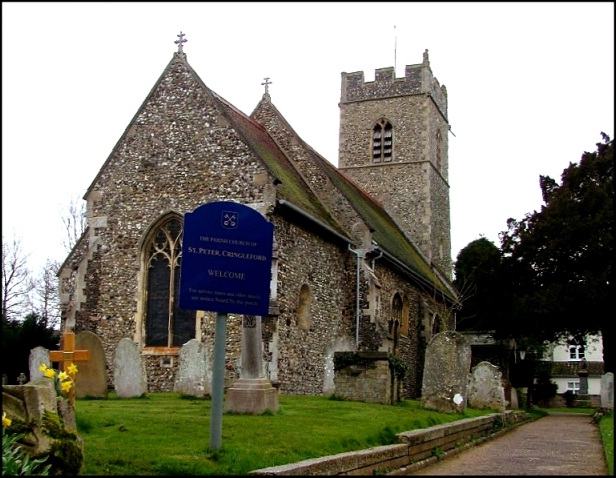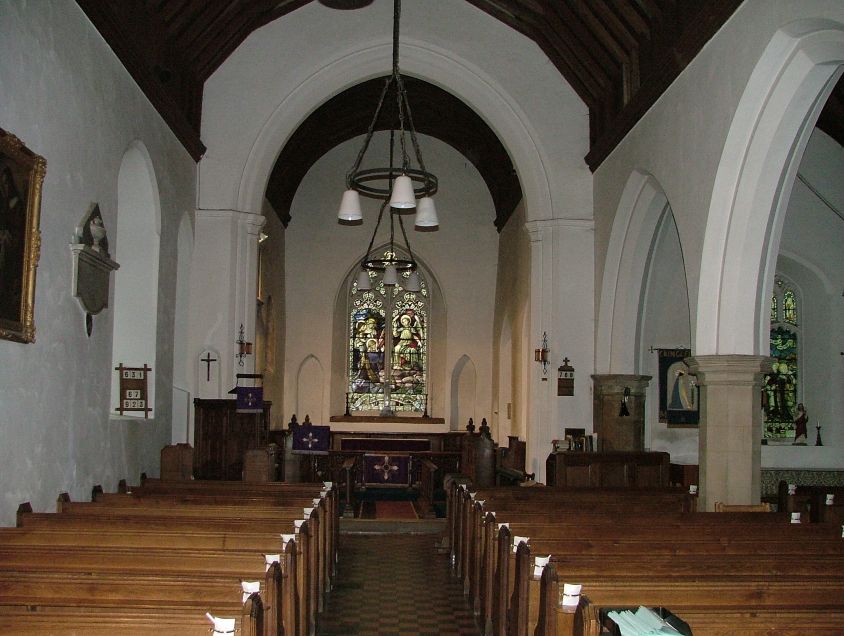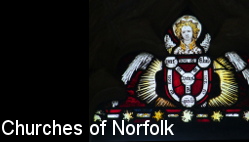Heading south-west out of Norwich, you come to the pleasant old village of Cringleford, now part of the urban area and within the southern bypass, but by the slip of a bureaucrat's pen still outside the city boundary. As Peter pointed out, it was once a much busier place, because the main street was once the road from London to Norwich. What a welcome sight this little church must have been in centuries gone by for people who had made that long journey! I wondered how many medieval merchants and travellers had stopped off at St Peter to offer a rosary of thanks.

Saint Peters Church
There are still old houses around the church, giving this part of Cringleford a villagey feel, especially now that the traffic has gone. Like neighbouring Eaton, this church is open and welcoming every day, to the extent of having a big sign telling you so, and the outer door locked open. This is a wonderful thing to find in the suburbs of a city - indeed, at any church - and I do hope the parish will be richly rewarded for its openness.
If you approach the church from the east, an intriguing building unfolds before you. You can see straight away that this is a very old survival, certainly early Norman at the latest, and quite probably late Saxon. That it has survived without rebuilding near a city which was, in late Medieval times, one of the busiest and richest in England, is remarkable. The chancel with its double-splayed north window is one of the earliest in East Anglia. Later windows have been put through, and a filled-in archway behind a 19th century buttress by the north porch suggests that once there might have been a chapel here, possibly to do with travellers from London?
The tower is much later, probably 14th century, and there is a south aisle of the 1890s. That St Peter underwent such a late restoration was to its benefit, because people were much more careful about preserving the past in the 1890s than they had been forty years earlier. The south aisle creates a squareness, with the chancel off at one corner. The arcade appears to be late medieval, and Pevsner suggests that the new aisle replaced an older one. The great excitement of the interior is one of the finest collections of glass, medieval and modern, in the urban area. In the upper lights are figures of the 15th century Norwich School, including a cowled figure who may be a peasant or a monk, and a Saint with the familiar barley corns strewn at his feet.

Much of the glass dates from the 1898 restoration, and is by Lavers & Westlake. The best is probably the crucifixion in the south chancel window, but there are also intriguing 20th century figures in the nave in a late medieval style depicting Adam of Berford and Alvredus of Cringleford, along with St Giles and St Edward the Confessor. The font is a good one, and must be very late 15th century if not a little later, with the vine trail which would become a motif of what would have been the English Renaissance if the Puritans hadn't stepped in. Above it is something much earlier, a coffin lid incorporating saxon interlace. There are some more intriguing sculpted blocks set below the window in the blocked south doorway of the chancel. Could they be Norman, or even Saxon? Opposite them, the faded decorative painting in the splayed window is surely Saxon. It surrounds an exquisite World War One memorial image of St George of England.
This information was taken from the fantastic website, Norfolkchurches.co.uk and more photos and info can be found here:

Please note that the cache is not located in the church grounds but is open for public worship so feel free to pop in for a visit!
**************************************
For full information on how you can expand the Church Micro series by sadexploration please read the Place your own Church Micro page before you contact him at churchmicro@gmail.com.
See also the Church Micro Statistics and Home pages for further information about the series.
*************************************